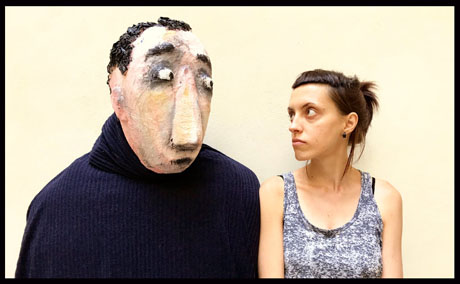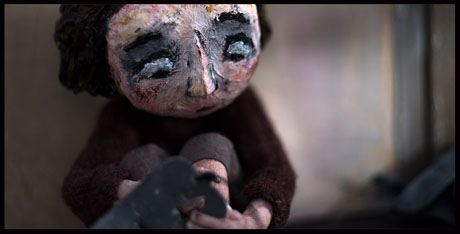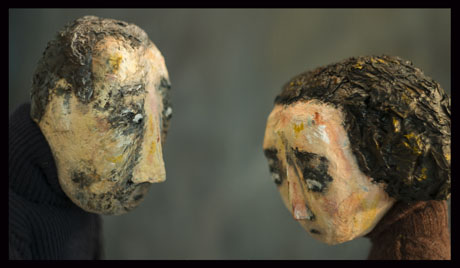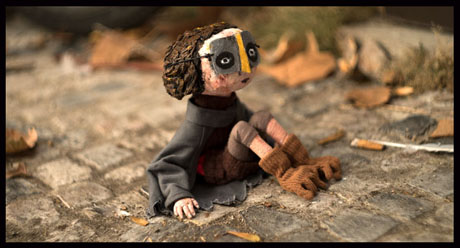
One of this year’s Best Animated Short Film Oscar nominees has already won an Oscar. In September, Daria Kashcheeva won a Student Academy Award for Best International Animated Short Film for her stop-motion drama (Dcera) Daughter. Now, she’s heading back to Los Angeles for the 92nd Oscars ceremony on Feb. 9.
Jackson Murphy: You made your short as a student at the Film & TV School of the Academy of the Performing Arts in Prague. And in September, you won the Student Academy Award. First of all, tell me about that experience.
Daria Kashcheeva: It was really great. They called me one day before I had my final exams at FAMU… so I wasn’t really prepared. They called me and they told me that I won the Student Oscar, and I was so excited. I couldn’t study. It was a very, very strange night and morning after. Czech TV came to my exam and wanted to do an interview. I was really happy, of course. One of the reasons why it was so important is because in Czech, 30 years ago there was a Student Oscar in Czech. In all the history – only two Student Oscars. It was very nice, and I was very honored.

Daria Kashcheeva: To go to Los Angeles and to have this experience was really interesting. I understood that the European system and the American system are very different. As I talked with American animators who got the Student Oscar as well, for them – their future was… they wished to work as an animator at Pixar or Disney or any big studio. But as they told me, they don’t really have possibilities to make their own other films. So here in the Czech Republic and in Europe, it’s really different because there are opportunities to make your own other films. There’s a lot of support from state cinematography funds. There are possibilities to make a different production between European countries. It was interesting for me to know about this.
And of course the ceremony was very nice. Members of my team also came to Los Angeles, and we really enjoyed it.
JM: I can’t believe this was going on when you were taking your Finals. Did you still do well on them even with all the distractions?
DK: (laughs) I wasn’t so good because I didn’t sleep because of the TV and so on. But my teachers were really nice, and they liked my film. And the next day after my Final Exams, I had my Entrance Exams to the Master Program. When I came to the exam, they told me, “Oh. We will have you… in this school.” And I said, “Oh, I’m really surprised.” So it was a funny day.
JM: I loved watching in your speech, which is available on the Oscars YouTube account, that you mentioned that about 5 years ago… you changed your profession to animation, which is incredible. How did that happen?
DK: I started as a sound designer in Moscow in Russia. And after I graduated, I continued my work as a sound designer in theaters. I really missed creativity – that I could make my own things. Also my husband who was an actor was also thinking if this profession is a really good choice for him. We wanted to go to Europe to study, and we knew about FAMU – that it is a really good and famous school – a lot of great films from graduates.
We tried to enter FAMU, and my husband was accepted on the first [try], and I wasn’t [right away]. My drawing wasn’t so good. They told me that if I wanted to try again, I really needed to work on my drawing. I started to practice in my drawing a lot – and in a year… the next time was successful.

JM: That’s great. And your short is already a rarity because you’ve already won the Student Oscar… you’re already an Oscar winner… but the Student Short Film winner is now in the major Oscar category. That’s rare. What was your instant reaction when you found out this news?
DK: It was really cool. We watched the announcement live on Facebook, and we watched it at our Dean’s office with our producer and my husband, who’s also the editor of the film. We were really happy about this. There is another student film in the [category], “Sister”, which is a CalArts film.
JM: Yes, I interviewed the director of “Sister”, Siqi Song, as well.
DK: And it’s really cool that the Oscars accepts student films. Also I’m really happy that there are three puppet animation films that are nominated. It’s a really good trend. I love puppet animation. I love stop-motion and handmade things. I’m really happy that the trend is turning from 3D to puppet animation.
JM: Daughter is about the relationship between a father and a daughter at a critical time, with a bird at its center. First off – what was the overall inspiration for this?
DK: I always was interested in psychology. I read a lot of articles and some books about how childhood could really influence us for our whole life. And our relationships with our parents are really crucial for us as people. Because I was really interested in this topic, I started to think about my past – my relationships with my parents, and I found some moments which I kept in my mind – and maybe were in my subconscious. I tried to think about them. It wasn’t like I brought a bird to my father – it wasn’t that situation.
I wanted to share my experiences – to share my feelings with my parents. I demanded them to give me hugs and love. I think each of us has these kinds of things. It’s normal. Parents couldn’t pay all the attention to their children. I started to think about how to show it in film because in film you have to have a metaphor… how to show feelings. You don’t want to just say that the girl has so many emotions. In this way, the idea of that bird came to me because when children see and think about death for the first time, it’s really emotional for children.
After that, this metaphor… worked really good for the story. This mask which the girl made represents a fence and the father kept this mask with him for his whole life. At the end of the film, the girl understands that the father kept this mask because he kept the memory of this moment.

JM: And I also love the handheld camera style you use, which is very rare in animation – and tight close-ups of the characters. Why did you decide to do that?
DK: I always loved cinematographer work in films. I always admired this ability… to show the feelings and emotions of the cinematographer. I was at the cinema at a really boring film, but the cinematographer work was really great. And it was at that moment when I started to figure out my Bachelor film. I already knew that it was gonna be puppet animation. I felt really inspired by the idea of, ‘What if I could do handheld camera work in my film?’ I started to write down all the ideas.
After that, I started to think about, ‘What is handheld camera for me?’ I always love films by Lars Von Trier and all the “Dogme” films. So I watched those films again, and I understood that this kind of documentary style really could work good for my story. I had to find a way how to animate it because I made it manually. I didn’t make it in post-production. I really animated the camera movements frame by frame during the animation. When I made the tests, I wasn’t really sure if it would work – if I could make this movement.
Then I made a teaser for… a pitching firm in Czech. And it was accepted really well. We got feedback from professionals, who told us they never saw this kind of style before in puppet animation and that it works really good for puppet animation. It was an inspiring moment, and we understood that we are on a good way.
JM: One of the specific standout sequences that I like is the bird nest sequence. What kinds of materials and techniques did you use for that particular sequence?
DK: I just used small branches, which I found in the forest. I put in more and more, frame by frame, and the nest was growing!
JM: And to me, it looked like doing the eye blinking for the characters was challenging. How did you pull that off?
DK: For the most important scenes, when the facial expressions were very important, I filmed myself. I acted by myself in front of the camera, and after, I copied my eye movements to my animation. I copied, frame by frame, how long the pupils stay in one place – how many frames it would take for the pupil to go in any direction. How long is blinking? It made this feeling of alive eyes.

JM: You’re already working on a new movie. What can you tell me about that?
DK: I just started my Master program at FAMU, because Daughter is my Bachelor film. It is going to be my Master film – it’s going to be in more professional conditions because we already have support from the Czech Cinematography Fund. It’s going to be stop-motion, but I want to combine puppet animation with pixelation and maybe live-action. I really want to have actors in my film. The topic is about a woman who is looking to accept her own body through her experiences in sexuality and in relationships with men – and experiences she remembers about her parents’ relationship.
JM: That’s really interesting that you want real actors in your next film because a lot of times, animation filmmakers don’t want to go into live-action or are afraid of going into live-action. But you’re comfortable and ready for that.
DK: I want to find how to combine animation of objects with live-action. I’m thinking about live-action because when you make a pixelation film, sometimes it looks very comic when an actor moves very strange. I want to avoid this because it’s not a comic film. So I’m thinking about how to find a solution – to connect live-action with stop-motion. I’m going to make tests, so we’ll see!
JM: So, you’ve already given one great speech. Will you write another one and have it on Oscar night?
DK: (laughs) I don’t have it ready, but I’m thinking I should prepare it. If it happens, I think would be really nervous. I’m thinking about what I would like to talk about.
- INTERVIEW: Strap In For “Mars Express” - April 30, 2024
- INTERVIEW: Jeff Fowler On “Knuckles” And “Sonic 3” - April 22, 2024
- INTERVIEW: “Inside Out 2” Director And Producer On Pixar Sequel - April 16, 2024


 January 29th, 2020
January 29th, 2020  Jackson Murphy
Jackson Murphy  Posted in
Posted in  Tags:
Tags: 






